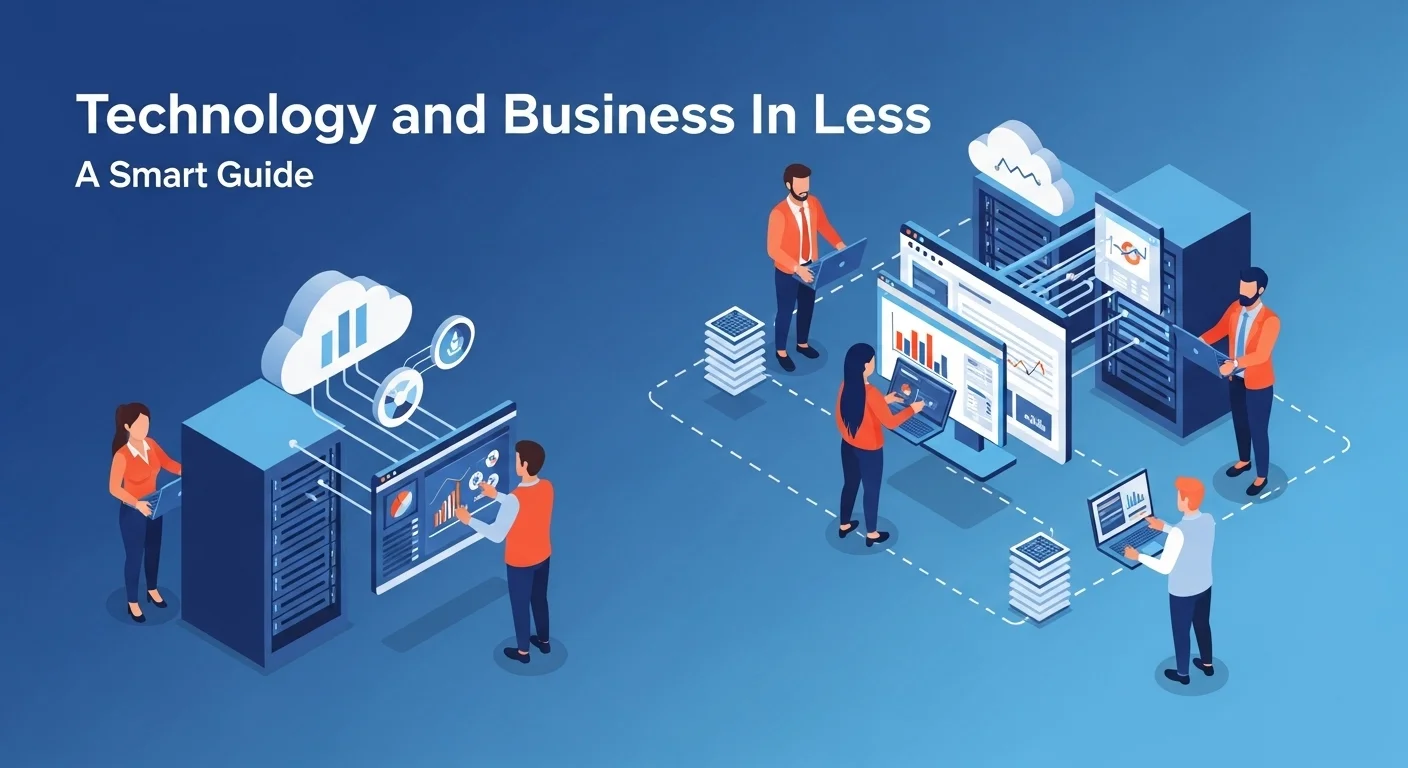AI Business Intelligence: How to Turn Your Company's Data into a Crystal Ball

Executive Summary
In my years as a data strategist, I've seen countless companies drowning in a sea of data but starving for real insights. They had the numbers, but not the story. That's where the magic of AI Business Intelligence (AI BI) comes in. It’s a game-changer that takes us beyond just looking at past reports. Instead of a rearview mirror, AI BI gives you a crystal ball, using predictive power to show you what's coming next and even suggesting the best path forward. For anyone in business or tech today, getting a handle on this isn't just a good idea—it's essential for survival and growth. This article is your guide to understanding AI Business Intelligence. We'll break down what it is, why it matters, and how it can turn your data from a confusing flood into your most powerful asset, fueling smarter decisions and real innovation.
Table of Contents
What is AI Business Intelligence and Why Should You Care?
For years, we've thought of data as the new oil. But just like crude oil, raw data isn't very useful until you refine it. That’s what Business Intelligence (BI) has always done. It gave us the tools to collect and analyze data, creating reports and dashboards that told us what happened last quarter or which products sold best. It was fantastic for looking back. I remember building dashboards that gave executives a perfect picture of the past. But in today's world, moving at lightning speed, looking backward is like driving by only using the rearview mirror. You'll miss the turn right in front of you.
The problem with this traditional approach is that it gets overwhelmed by the sheer amount of data we have now—so-called Big Data. Even the sharpest human analyst can't possibly spot every hidden pattern or connection in billions of data points. And by the time they do, the opportunity might have already passed. We needed something more—something faster, smarter, and more forward-looking. That need gave birth to the next great leap: AI Business Intelligence.
The Dawn of a New Era: AI-Powered Insights
AI Business Intelligence is what happens when you infuse traditional BI with the power of Artificial Intelligence. It’s a total shift in thinking. We move from just describing what happened to diagnosing why it happened, predicting what will happen next, and even prescribing what you should do about it. It’s the difference between seeing a dip in sales and having a system that tells you, 'Your sales are dropping because of competitor X's new campaign, and if you offer a 10% discount to this specific customer segment, you can reverse the trend.' This incredible power comes from technologies like machine learning (ML) and natural language processing (NLP).
Here’s how AI-powered business intelligence changes the game:
- Automated Insights: I've seen teams spend weeks trying to find the 'why' behind a number. Machine learning algorithms can analyze enormous datasets in minutes, automatically flagging important trends and outliers you'd never see on your own. For example, it might spot that a drop in customer satisfaction in one region is directly linked to a specific software bug, all without a single person having to dig for it.
- Predictive Analytics: This is where the crystal ball comes in. By learning from your historical data, AI can make incredibly accurate forecasts. Imagine knowing which customers are likely to leave in the next 30 days, how much inventory you'll need for the holiday season, or which sales leads are a sure bet. This lets you move from reacting to problems to proactively shaping your future.
- Prescriptive Analytics: This takes it a step further. It doesn’t just predict a problem; it suggests a solution. If it forecasts a supply chain delay, it might recommend rerouting a shipment through a different port and even calculate the cost difference for you. It becomes a true strategic partner.
- Natural Language Processing (NLP): This is one of my favorite parts because it makes data accessible to everyone. You don't need to be a data guru anymore. Anyone can ask a question in plain English, like 'Show me our best-performing ads this month,' and get an instant chart or answer. This breaks down the walls between data and the people who need it most, creating a truly data-driven culture.
The Real-World Importance of AI in Business Intelligence
The tech behind AI BI isn't just a fancy add-on; it's a fundamental upgrade for how we handle information. It tackles the biggest challenges of the modern data world head-on.
1. Taming the Big Data Beast
We generate an incredible amount of data every second from social media, smart devices, and customer clicks. AI-powered business intelligence systems are built to thrive in this environment. They can analyze streaming data in real time, allowing an e-commerce site to personalize your shopping experience as you click, making a sale more likely.
2. Automating the Grunt Work
Believe it or not, up to 80% of any data project used to be just cleaning and preparing the data. It was tedious and slow. AI automates this, intelligently fixing errors, filling in gaps, and standardizing data from different sources. This means faster insights and, more importantly, insights you can actually trust.
3. Understanding Human Language
So much valuable information is hidden in unstructured data like emails, customer reviews, and support calls. Traditional BI can't touch this stuff. But with AI, we can analyze customer reviews to understand brand sentiment or scan support tickets to find recurring product complaints. It unlocks a treasure trove of insights that were previously invisible.
4. Making Everyone a Data Analyst
In the past, if you had a business question, you had to file a ticket with the BI team and wait. AI Business Intelligence changes everything. With tools like natural language queries, a marketing manager can explore sales data on their own, and a CEO can get financial snapshots without needing a programmer. This self-service approach empowers everyone to make better, evidence-based decisions.
Practical Applications and Surprising Benefits
The impact of AI for business intelligence is felt everywhere, delivering real-world results that boost efficiency, revenue, and customer happiness.
- Marketing & Sales: Imagine creating marketing campaigns so personalized they feel like they were made for one person. AI makes that possible. It can also score sales leads to tell your team where to focus their energy for the best results.
- Finance: AI is a powerhouse for detecting fraudulent transactions in real time and assessing credit risk more accurately than ever before. It also automates financial reporting, freeing up your finance experts to think about strategy, not spreadsheets.
- Operations & Supply Chain: Companies use AI to predict demand with stunning accuracy, ensuring they never run out of popular products or have too much of others. It can even predict when a machine in a factory needs maintenance before it breaks down, saving millions in downtime.
- Human Resources: AI can help HR find the perfect candidate by analyzing resumes more effectively and can even predict which employees might be unhappy, giving the company a chance to improve their experience.
In short, AI Business Intelligence is here now, and it's transforming how we work. It turns BI from a passive reporting tool into an active, intelligent guide. By automating the difficult parts, predicting the future, and making data a conversation, AI-powered business intelligence gives businesses the clarity and speed they need to win. It's a journey from hindsight to foresight, and it's one every modern organization needs to take.

Your Complete Guide to Implementing AI Business Intelligence
Bringing AI Business Intelligence to life in your organization is an exciting journey that blends cutting-edge technology with smart business strategy. It's not just about installing new software; it's about building an engine for growth. I've guided many teams through this process, and I've learned that success comes from understanding both the technical nuts and bolts and the human-centric strategies. This guide will walk you through the methods, strategies, and tools you need to build a powerful AI-powered business intelligence ecosystem.
The Technical Engine: How AI Business Intelligence Works
At its heart, AI for business intelligence is driven by a few core AI and machine learning technologies. Getting comfortable with these concepts is your first step. The workflow is usually pretty logical, moving from gathering data to making predictions.
1. Building a Strong Data Foundation
I can't stress this enough: your AI is only as good as your data. The old saying 'garbage in, garbage out' has never been more true.
- Data Integration: Your AI needs to feast on data from all over your business—your CRM (like Salesforce), your ERP (like SAP), databases, and even external feeds like social media. The goal is to bring it all together for a single, unified view.
- Data Cleaning: Raw data is always messy. This stage is about fixing the typos, filling in the blanks, and removing duplicate entries. It used to be a manual nightmare, but thankfully, AI can now automate a lot of this tedious work.
- Feature Engineering: This is where the art meets the science. It's about choosing the right data signals (features) for your model to learn from. For example, if you want to predict which customers might leave, features like 'days since last purchase' or 'number of support tickets' are crucial. It's a creative process that has a huge impact on your model's accuracy.
2. Choosing the Right AI Model for the Job
Different business questions require different tools. Selecting the right type of machine learning model is a key strategic decision in any AI and business intelligence project.
- Classification Models: Use these when you need a 'yes/no' or categorical answer. Think of it for: Is this email spam? Is this review positive or negative? Will this customer churn? Is this transaction fraudulent?
- Regression Models: Use these when you need to predict a specific number. Think of it for: How much revenue will we make next quarter? What is the lifetime value of this customer? What will our demand be for this product?
- Clustering Models: Use these when you want to find natural groupings in your data without any preconceived labels. Think of it for: Segmenting your customers into distinct personas for marketing, or identifying strange behavior that could be an anomaly.
- Time-Series Forecasting Models: These are specialists for predicting future values based on a time sequence. Think of it for: Forecasting stock prices, website traffic, or seasonal inventory needs.
3. The Advanced Tech That Makes It Magic
Beyond the basic models, some truly advanced AI is what elevates business intelligence with AI to the next level.
- Natural Language Processing (NLP): This is the tech that lets you 'talk' to your data. It understands human language, allowing it to analyze customer comments for sentiment, pull key information from documents, and power those search-bar-style queries.
- Deep Learning & Neural Networks: When you have incredibly complex problems, like identifying products in customer photos or understanding nuanced speech, you bring in the heavy hitters. Deep learning is behind some of the most amazing AI breakthroughs.
- Reinforcement Learning: This is a fascinating area where an AI model learns through trial and error, like a person learning a new game. It's perfect for prescriptive tasks, like figuring out the optimal pricing for a product by testing different strategies in a simulation.
The Business Playbook: Strategy is Everything
Amazing technology will fail without a smart business plan. A successful AI Business Intelligence program is driven by clear goals and a supportive culture.
1. Start with 'Why?': Define Your Mission
I've seen projects fail when the goal was simply 'to use AI.' That's a recipe for disaster. Start with a real business problem. A great goal sounds like: 'We want to reduce customer churn by 15% in the next year by predicting at-risk customers.' That's specific, measurable, and gives your team a clear target to aim for.
2. Build a Data-Driven Culture
For this to work, everyone from the CEO to the summer intern needs to be on board. This means:
- Leadership Buy-In: Your executives need to be the biggest cheerleaders for the project.
- Invest in Your People: Train your employees on how to use the new tools and, more importantly, how to think with a data-first mindset.
- Break Down Silos: AI projects are a team sport. You need your IT, data science, and business teams all working and communicating together.
3. Be Agile: Start Small, Win Big
Don't try to solve all your problems at once. Pick a small, well-defined pilot project that can deliver a quick, visible win. This builds momentum and confidence. From there, you can iterate and expand, learning as you go. It's a marathon, not a sprint.
4. Govern with Wisdom and Ethics
With great data power comes great responsibility. A strong governance framework is non-negotiable. This means:
- Data Quality & Security: Ensuring your data is accurate, consistent, and protected from unauthorized access.
- Ethical AI: This is huge. You must actively work to ensure your AI models are fair and unbiased. A biased model could discriminate in hiring or lending, leading to disastrous consequences. Transparency—being able to explain why an AI made a certain decision—is key to building trust.
The Tools of the Trade: Your AI BI Toolkit
The market is full of fantastic AI-powered business intelligence tools. Here are a few leaders:
- Major Platforms: Tools like Microsoft Power BI, Tableau (Salesforce), and Qlik Sense have all deeply integrated AI features, offering automated insights and natural language queries right out of the box.
- Cloud AI Platforms: The giants—Amazon Web Services (AWS), Google Cloud Platform (GCP), and Microsoft Azure—provide the powerful infrastructure and services to build completely custom AI models that can be plugged into any BI tool.
- AutoML Tools: Platforms like DataRobot and H2O.ai are democratizing AI by automating the complex process of model building, allowing teams with less data science expertise to create powerful predictive models.
Ultimately, a complete approach to AI Business Intelligence is about marrying powerful technology with a clear, ethical, and human-focused business strategy. By starting with a solid data foundation, focusing on real business value, and building a culture that embraces data, you can turn the incredible promise of business intelligence with AI into a tangible, game-changing reality.

Practical Tips and Strategies to Master AI Business Intelligence
Rolling out AI Business Intelligence is more than a tech upgrade; it’s about weaving a new, smarter way of thinking into the fabric of your organization. To really get the most out of it, you need to go beyond the software and adopt a set of strategic practices. From my experience in the field, success hinges on a relentless focus on quality, security, and ethics. Here are my go-to tips and strategies to help you master AI-powered business intelligence and create a real competitive edge.
Best Practices for a Healthy AI BI Ecosystem
Think of these as the fundamental rules for making sure your AI for business intelligence initiatives are effective and sustainable for the long haul.
1. Your AI is Only as Smart as Your Data: A Lesson I Learned the Hard Way
Early in my career, a project I was on built a stunningly complex model that produced complete nonsense. Why? The source data was a mess. An AI trained on flawed data will only give you flawed answers, faster.
- Establish Data Governance: Create a dedicated team from across the business to set the rules for data quality, standards, and ownership. This creates accountability.
- Automate Quality Control: Use AI-powered tools to constantly scan your data for errors and anomalies. Think of it as a 24/7 data supervisor.
- Create a Data Catalog: This is like a library card catalog for your data. It tells everyone what data you have, where it came from, and what it means, which is essential for building trust.
2. Embrace Explainable AI (XAI): Open the Black Box
Some of the most powerful AI models can be 'black boxes,' meaning even their creators don't know exactly how they reached a decision. This is a huge problem. You can't trust a recommendation if you don't know the 'why' behind it.
- Favor Simpler Models First: When you can, start with models that are easier to interpret, like decision trees. Don't jump to the most complex solution if a simpler one works.
- Use XAI Tools: There are fantastic tools (like LIME or SHAP) that help explain a model's decisions. For example, if an AI denies a loan application, XAI can show you it was because of a high debt-to-income ratio, not an unfair bias. This is critical for debugging, compliance, and getting people to actually trust and use the system.
3. Adopt MLOps (Machine Learning Operations): Manage Your Models Like a Pro
An AI model isn't a 'set it and forget it' tool. The world changes, and your model's accuracy can fade over time—a problem we call 'model drift.' MLOps is a set of practices for managing the entire lifecycle of your models.
- Automate Everything: Build an automated pipeline that handles everything from data preparation and model training to deployment and monitoring. This reduces errors and gets new insights into production faster.
- Monitor for Drift: Constantly check your model's performance against real-world results. Set up alerts that trigger an automatic retraining process when performance starts to slip.
4. Foster a Culture of Continuous Learning
The world of AI changes every day. The best teams I've worked with are the ones that are always learning.
- Invest in Your People: Give your team access to training, workshops, and certifications in AI and data science. A small investment here pays huge dividends.
- Create a Safe Sandbox: Give your teams a safe environment where they can experiment with new ideas and tools without any risk of breaking your live systems. This encourages innovation.
Real-World Tools and Experiences
Seeing how these tools work in practice is key to understanding the potential of AI and business intelligence.
Tool Spotlight and Use Cases:
- Salesforce Einstein: This is a great example of seamlessly embedding AI right where people work.
- The Experience: A sales manager logs into Salesforce and immediately sees a dashboard where every deal is scored by Einstein. The AI has already analyzed thousands of past deals to predict which ones are most likely to close. The sales team now knows exactly where to focus their energy, and their win rates skyrocket. It's not just data; it's direction.
- Microsoft Power BI with Azure ML: This powerful duo lets you combine user-friendly dashboards with custom-built AI.
- The Experience: A retail chain uses Azure ML to build a sophisticated demand forecast model. This isn't a generic forecast; it's tailored to their business. The model's predictions are piped directly into a Power BI dashboard. Now, a store manager can see not just her current inventory, but an AI-powered forecast for the next month, allowing her to prevent stockouts before they happen. This is business intelligence with AI in its purest form.
- ThoughtSpot: This platform is all about making analytics as easy as a Google search.
- The Experience: A marketing VP wants to know how her latest campaign performed. Instead of waiting days for a report, she types, 'Compare revenue from our summer social media campaign to our spring email campaign by customer location.' Instantly, ThoughtSpot generates a map and a chart with the answer. She can make a budget decision right there on the spot.
A Quick Word on AI and Cybersecurity
Don't forget that AI BI can be one of your best security guards. Security teams are overwhelmed with alerts, and AI is brilliant at spotting the real threats in all that noise.
- Threat Detection: AI can learn the normal rhythm of your network. When it sees something unusual—like an employee downloading huge files at 3 AM—it can raise a red flag instantly.
- Automated Response: Better yet, when a threat is found, an AI system can automatically quarantine the affected computer, stopping an attack in its tracks while the human experts investigate.
Quality External Resources
To stay on top of this fast-moving field, continuous learning is key. For those who want to get their hands dirty with the technology, a fantastic resource is Google's TensorFlow Tutorials. It offers practical, hands-on guides that are invaluable for building technical skills. Engaging with resources like this ensures your team is always using the best and most current techniques.
In summary, enhancing your business with AI Business Intelligence is a holistic journey. It's built on a bedrock of best practices like data governance and MLOps, brought to life by the right tools, and protected by a smart approach to cybersecurity. By focusing on explainability and ethics, you build the trust needed for adoption. And by fostering a culture of learning, you ensure your organization doesn't just keep up, but leads the way. This comprehensive approach turns your AI-powered business intelligence platform into a true strategic asset that fuels growth across your entire enterprise.
Expert Reviews & Testimonials
Sarah Johnson, Business Owner ⭐⭐⭐⭐
As a small business owner, I found this insightful. I wish there were a few more step-by-step examples for companies my size, but it's a great starting point.
Mike Chen, IT Consultant ⭐⭐⭐⭐
A solid overview of AI Business Intelligence. It clarified some complex topics for me. A glossary of terms would have been a perfect addition!
Emma Davis, Tech Expert ⭐⭐⭐⭐⭐
Fantastic article! As a tech specialist, I appreciate the depth and clarity. This piece perfectly bridges the gap between the technical details and the strategic business value. Highly recommended.



